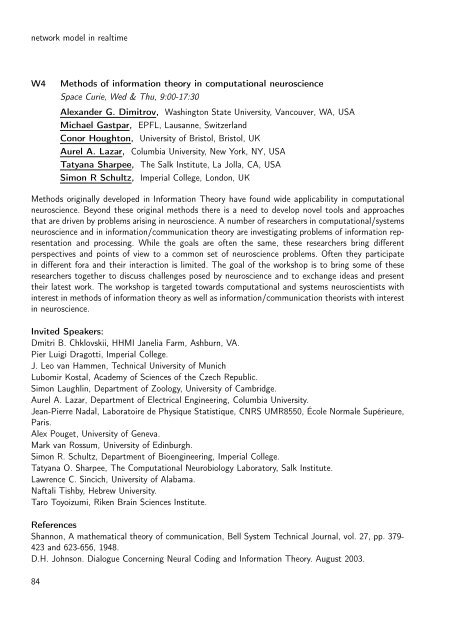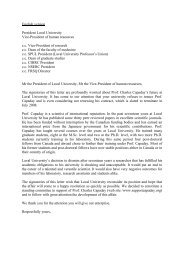Untitled - Laboratory of Neurophysics and Physiology
Untitled - Laboratory of Neurophysics and Physiology
Untitled - Laboratory of Neurophysics and Physiology
You also want an ePaper? Increase the reach of your titles
YUMPU automatically turns print PDFs into web optimized ePapers that Google loves.
network model in realtime<br />
W4<br />
Methods <strong>of</strong> information theory in computational neuroscience<br />
Space Curie, Wed & Thu, 9:00-17:30<br />
Alex<strong>and</strong>er G. Dimitrov, Washington State University, Vancouver, WA, USA<br />
Michael Gastpar, EPFL, Lausanne, Switzerl<strong>and</strong><br />
Conor Houghton, University <strong>of</strong> Bristol, Bristol, UK<br />
Aurel A. Lazar, Columbia University, New York, NY, USA<br />
Tatyana Sharpee, The Salk Institute, La Jolla, CA, USA<br />
Simon R Schultz, Imperial College, London, UK<br />
Methods originally developed in Information Theory have found wide applicability in computational<br />
neuroscience. Beyond these original methods there is a need to develop novel tools <strong>and</strong> approaches<br />
that are driven by problems arising in neuroscience. A number <strong>of</strong> researchers in computational/systems<br />
neuroscience <strong>and</strong> in information/communication theory are investigating problems <strong>of</strong> information representation<br />
<strong>and</strong> processing. While the goals are <strong>of</strong>ten the same, these researchers bring different<br />
perspectives <strong>and</strong> points <strong>of</strong> view to a common set <strong>of</strong> neuroscience problems. Often they participate<br />
in different fora <strong>and</strong> their interaction is limited. The goal <strong>of</strong> the workshop is to bring some <strong>of</strong> these<br />
researchers together to discuss challenges posed by neuroscience <strong>and</strong> to exchange ideas <strong>and</strong> present<br />
their latest work. The workshop is targeted towards computational <strong>and</strong> systems neuroscientists with<br />
interest in methods <strong>of</strong> information theory as well as information/communication theorists with interest<br />
in neuroscience.<br />
Invited Speakers:<br />
Dmitri B. Chklovskii, HHMI Janelia Farm, Ashburn, VA.<br />
Pier Luigi Dragotti, Imperial College.<br />
J. Leo van Hammen, Technical University <strong>of</strong> Munich<br />
Lubomir Kostal, Academy <strong>of</strong> Sciences <strong>of</strong> the Czech Republic.<br />
Simon Laughlin, Department <strong>of</strong> Zoology, University <strong>of</strong> Cambridge.<br />
Aurel A. Lazar, Department <strong>of</strong> Electrical Engineering, Columbia University.<br />
Jean-Pierre Nadal, Laboratoire de Physique Statistique, CNRS UMR8550, École Normale Supérieure,<br />
Paris.<br />
Alex Pouget, University <strong>of</strong> Geneva.<br />
Mark van Rossum, University <strong>of</strong> Edinburgh.<br />
Simon R. Schultz, Department <strong>of</strong> Bioengineering, Imperial College.<br />
Tatyana O. Sharpee, The Computational Neurobiology <strong>Laboratory</strong>, Salk Institute.<br />
Lawrence C. Sincich, University <strong>of</strong> Alabama.<br />
Naftali Tishby, Hebrew University.<br />
Taro Toyoizumi, Riken Brain Sciences Institute.<br />
References<br />
Shannon, A mathematical theory <strong>of</strong> communication, Bell System Technical Journal, vol. 27, pp. 379-<br />
423 <strong>and</strong> 623-656, 1948.<br />
D.H. Johnson. Dialogue Concerning Neural Coding <strong>and</strong> Information Theory. August 2003.<br />
84



